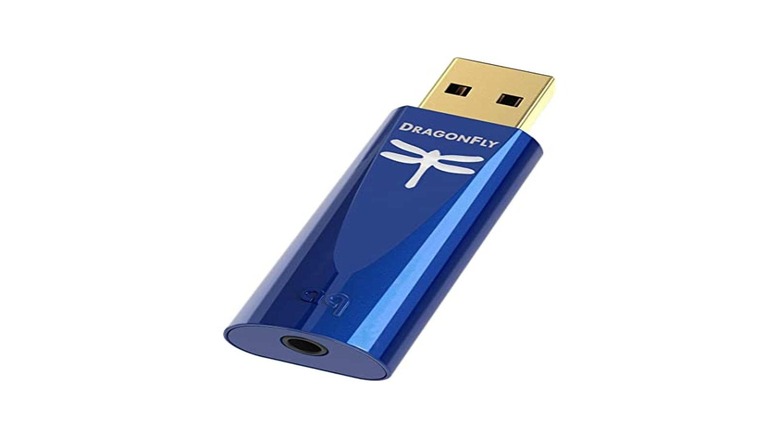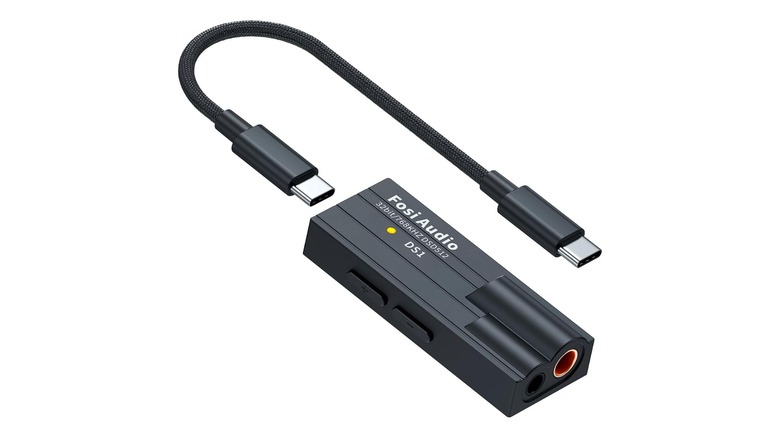What Are USB DACs And Why Would You Want One?
We may receive a commission on purchases made from links.
You've probably heard the arguments that digital music — or at least CD-quality digital music — is inherently flawed compared to all-analog formats like vinyl records, making it a major reason why people buy more new vinyls than used CDs these days. Your mileage may vary as to just how true that is and why, but there's no real disputing that bad, low-quality digital exists. There are many factors that impact this, with the most infamous probably being that it's much easier to push the limits of loudness and dynamic range compression in the digital realm. But the fact of the matter is also that, like with analog, some playback hardware is better than others. Just as you're going to get a higher quality vinyl playback experience from a brand like Rega or VPI over the more cheaply made options from companies like Crosley or Victrola, digital to analog converters (as well as the associated hardware like amplifiers) can also vary in quality.
Since a dedicated digital to analog converter (or DAC) is likely to do a better job than the onboard sound built into most computers (and whichever phones and tablets still have headphone jacks), there's a market for USB DACs to get more out of your digital music on your computer or mobile device. In addition, with hi-res digital music becoming a key feature on streaming services, hi-res DACs become more attractive to the average person. So let's take a look at what USB DACs are and why you might want one.
What exactly are USB DACs in the first place?
In basic terms, defining "USB DAC" is pretty simple: A digital to analog converter (DAC) for digital audio that interfaces with computers and mobile devices via a USB connection. Anything that fills that role is a USB DAC, even if that terminology might not be used in every scenario. Zooming out a bit, the sound card in any computer — or comparable hardware in a CD player — is a DAC, the part of the computer/device that decodes the ones and zeroes into beautiful music. The phrase "USB DAC," though, is generally used in the audiophile realm, where discerning listeners looking to maximize the quality of their digital audio output are willing to invest in USB DACs across many different price points to achieve that goal.
Searching Amazon for "USB DAC" gives you a taste of just how many different flavors of USB DAC are available. Prices start below $10 for simple headphone dongles and then start creeping up in price and size for external Creative Sound Blaster sound cards, then bang-for-your buck DACs from high-value budget hi-fi companies like Fiio, Fosi Audio, and Topping. Eventually, you see more established audiophile brands represented like AudioQuest, WiiM, and iFi as the price range reaches the hundreds of dollars, plus even bigger black boxes promising the finest in sound quality that creep into four figures. Exactly what variety of USB DAC you're looking for depends on your budget and why you're in the market.
Why would I want a USB DAC?
There are three main use cases for why you would buy some kind of USB DAC. The most common these days is probably getting a headphone dongle for a smartphone without a headphone jack. Those are simply inexpensive USB DACs in the smallest possible form factor, and they can vary wildly in price and quality. Another reason is that you're using a computer where the analog audio output broke, and you need a quick fix for a new analog output to headphones or a pair of computer speakers, so you get a USB sound card.
Finally, there's the use case that's most commonly associated with the term "USB DAC": You aren't happy with the quality of the audio output of your phone or computer and want something better that brings a higher level of fidelity, possible with support for high-resolution audio formats like Direct Stream Digital (DSD for short) or 24-bit, high sample rate PCM.
That last use case has become a lot more relevant to the average consumer than it used to be. For a long time, hi-res digital music was mainly the domain of spendy audiophiles with expensive systems, first via optical disc formats like DVD Audio and Super Audio CD, then with digital downloads from websites like HDTracks. Now, though? Hi-res content is a standard feature of major all-you-can-eat subscription music streaming services, so if you're already paying for it, you may want to harness the music's full fidelity.


